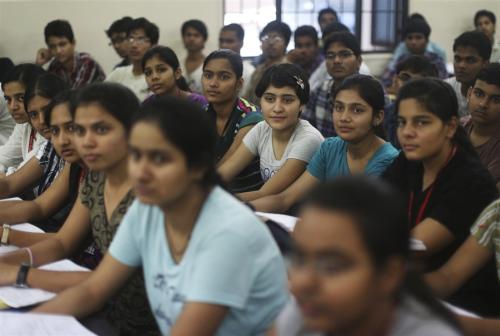 | « Back to article | Print this article |
Why India needs to create job opportunities urgently
The growth path going forward has to absorb the new entrants into the labour force, which are estimated at 4.5 million annually in the 12th Plan document.
Faced with the task of controlling the fiscal deficit, Union Budget 2013 shows a marked retreat from public expenditure on capital formation, and issues a corresponding invitation to the private sector to step up investment and saving.
The Budget proposes a number of excellent measures in this direction.
These have to be evaluated against the government's own assessment of the needs of the economy going forward, as set out in the draft 12th Five-Year Plan document, for the period 2012 to 2017. The first fiscal year of that period is already over.
The impressive growth record of this government in its first term in office was not matched by a corresponding growth in employment.
The National Sample Survey (NSS) employment surveys, held once every five years, are the only source of nationwide information on that front.
By coincidence, the years covered in the two most recent employment surveys, in the 61st and 66th rounds, were 2004-05 and 2009-10, the beginning and end years of the first term of this government.
The NSS data are extensively cited in the 12th Plan document and therefore carry the imprimatur of official acceptance.
Click NEXT to read more...
Why India needs to create job opportunities urgently
The total number of people absorbed into what might broadly be termed an employed state, either full-time or part-time, increased by a mere 2.76 million over the entire five years from 2004-05 to 2009-10.
By contrast, the corresponding increase in the preceding five-year period 1999-2000 to 2004-05, was 60.7 million.
What made for such a fantastic difference between these two periods?
The sectoral breakdown shows that construction is the major employment spinner. The 1999 to 2004 period saw a rapid rate of highway construction, and last mile connectivity for previously marooned rural habitats.
Even in the five years after 2004, with much slower highway development, construction added 18 million employed in terms of its direct impact alone, not counting its upstream impact through the demand for steel, cement and other materials.
The positive (direct) contribution of construction actually outweighed the negative growth in employment in manufacturing and other sectors in the second period, and tipped the overall change in employment into a small positive number.
Accordingly, the Budget for 2013-14 carries a large number of incentives for new construction.
An initiative to facilitate rural housing, started last year through a refinance window at the National Housing Bank, is said to have received a good response, and has been given additional funding.
Click NEXT to read more...
Why India needs to create job opportunities urgently
A similar fund for urban housing is to be started this year. Stalled projects for 3,000 kilometres of highway are announced to have been released for implementation within the first half of the year.
There is a much needed provision for funding of godowns to stock agricultural produce. A number of infrastructure financing initiatives will carry a construction component.
And some of the work on industrial corridors linking major cities may also begin during the year.
Employment provision has to be juxtaposed against the numbers entering the labour force.
The NSS surveys show stagnation in the absolute labour force over 2004-09, so that despite the poor employment increment, unemployment actually came down from 2.3 to 2 per cent.
The decline in labour force participation was a puzzle, and there remains a question mark over the plausibility of it.
The important issue is the required employment absorption, going forward. The 12th Plan document, based on further projected declines in the labour force participation rate in the age group 15 and above, estimates the increase in people looking for work at around 4.5 million annually, a roughly 1 per cent increase in the labour force per year.
Click NEXT to read more...
Why India needs to create job opportunities urgently
The Economic Survey, however, estimates the annual increase at a little over eight million.
Going with the 12th Plan figures, absorbing a 1 per cent increase in the labour force should not be very difficult at all.
Even with the present GDP growth rate of 5 per cent, that is only an asking employment elasticity of 0.2.
The achieved employment elasticity between 1999-2000 and 2004-05 was 0.44, but it fell to 0.01 between 2004-05 and 2009-10.
I have written earlier about the central failure of Indian reform, the total lack of attention to reforming the markets for land and labour ("Stallflation", Business Standard, December 25, 2012). This neglect has fed into poor employment generation, and has to be reversed.
In a recent statement on the land acquisition Bill, a minister of the government declared that any resulting delays are needed to serve the needs of the perspirational masses, as distinct from the aspirational classes.
Delays serve no purpose at all, least of all the needs of the poor. What does serve the interests of the poor is justice, quickly dispensed.
Click NEXT to read more...
Why India needs to create job opportunities urgently
As I have argued earlier ("Wanted: new financial instruments", Business Standard, May 29, 2012), a well-structured financial annuity in payment for acquired land, rather than a lump-sum payment, is what sellers of land really need.
This, together with an overall framework for rehabilitation of displaced people, once in place, will pose no delays in the case of any specific project.
But to delay the development of these frameworks, and to justify it in the name of the poor, does no one any good.
The important thing is to monitor delivery of the promised compensation, whatever it might be, so that the trust of people is not broken, as it repeatedly has been in the past.
The NSS surveys show that unemployment rates rise with the level of education. The highest rates are experienced among post-school diploma and certificate holders, which presumably reflects their poor employability.
The Budget speech rightly stresses the need for skill development, and sets aside Rs 1,000 crore (Rs 10 billion) for authorised certification procedures.
All excellent steps, needed and timely. But the finance ministry can only provide policy design and finance. It is left to the other ministries and agencies of the government to deliver.
The writer is a retired professor of economics





